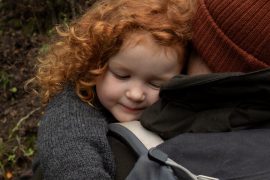At that age, she never questioned whether Santa was real. She simply went along with it.
As she got to the next Christmas, other well-meaning family members started telling her the story of Santa. Whether they played music like “Santa Claus is Coming to Town” for her, wrote his name as the giver of gifts, or simply asked her whether Santa had gotten her anything after the fact, suddenly, he was very much alive in her consciousness.
Of course, she started asking me about him. Children are great at intuiting the very questions we’d prefer they not ask us directly.
2. When she’d ask me, “Mama, is Santa real?” I’d reply, “What do you think?”
With bright eyes and great enthusiasm behind her question, she made it very clear that she wanted Santa to be real. The magic of Christmas was important to her in this way. I didn’t “feed” her belief by talking about him, but I welcomed the joy she found in him.
I treated him like another beautiful decoration to behold on the mantle – something we acknowledge, but that we wouldn’t spend a lot of time admiring.
Around that time, I decided to follow her lead. I wouldn’t tell her he didn’t exist, but I also wouldn’t tell her that he did.
Is a non-answer a lie? I don’t think so, in this case. Like all questions from kids, there’s a time and place when they’re ready to know certain things. For me, “Is Santa real?” falls into this category.
When she put me on the spot, I’d turn it around and ask what she thought. She always confirmed that he was, indeed, alive and well, living contentedly at the North Pole. I’d smile in response and perhaps give her a kiss. Sometimes, I’d talk about how wonderful it is to be a Santa. (There it is again.)
3. I avoided tying her behaviour to anything related to gifts.
Santa Claus comes no matter what. Period. As part of gentle parenting, her behaviour has nothing to do with whether Santa will come via reindeer to our rooftop on Christmas Eve. There’s no discussion of naughty or nice. We never talk about coal in the stocking or any of the other popular threats parents use.
Santa simply visits because my child is a child. That’s the only prerequisite.
Needless to say, Santa doesn’t judge others’ behaviour, either. It’s not part of his schtick. He’s entirely benevolent.
If other well-meaning parents or other people say to my child, “Were you a good girl this year?” I’m quick to respond on her behalf, “Of course! Santa has nothing to do with that. She’s a great kid.” End of story.
4. Santa brings fewer gifts than Mummy and Daddy do
We minimise the focus on Santa by limiting the number of presents from him. Granted, we’re not a present-focused family, anyway; commercialism isn’t our “thing.” Still, Santa may leave her gifts in her stocking and the rest are up to Mummy and Daddy. Or, Santa may give her a couple of small-ish gifts under the Christmas tree, but the ones about which she’ll get most excited are not from him.
And then we move on joyfully together. She’s never questioned the quantity or quality of Santa’s gifts.
How do I know this approach to Santa works?
I know because honesty worked for the Easter Bunny. He was my litmus test. My child figured out years ago that Mummy and Daddy are really the Easter Bunny, and when we had the discussion in the way that we did, she was absolutely fine with it. A large part of her ongoing trust in us is that we were honest with her when she was ready for the full story.










